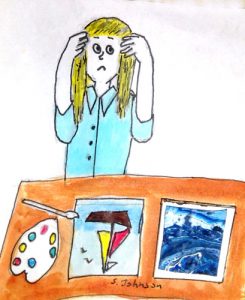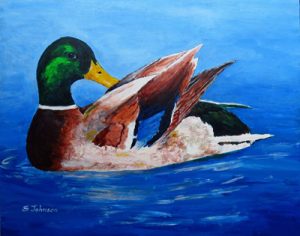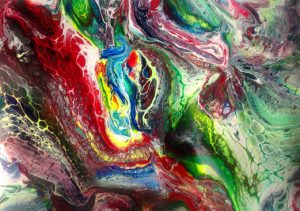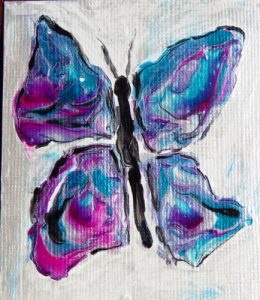
Anxiety can affect people in many ways. Creative people often struggle with anxiety about their creative process. This post is how EMDR helped one woman artist change her negative self-talk about her artistic talent to positive self-talk.
EMDR, which stands for Eye Movement Desensization Processing, is my favorite therapeutic technique. For many people it quickens the pace of progress in therapy. It is a practice of using bi-lateral stimulation, which could be through eye movements back and forth, a tone heard in one ear then the other ear or tapping one knee then the other knee.
My client, an artist, had an idea in her head of what she wanted to paint but was not able to sit down and paint the idea due to panic she felt when she thought of doing this. She said the idea was a more impressionistic kind of painting that was not her normal style and was larger than she usually painted. Her level of distress when she thought of painting the idea was a 8 out a scale of 1 to 10, (where 1 was no distress and 10 was the highest distress).
I also asked this client to rate beliefs she had about herself related to this painting idea. She rated feeling as true a 5 out of 7 for the belief: “I cannot succeed” and a 6 out of 7 on the belief “I have to be perfect”. I reversed these beliefs to what is known as positive cognitions. She rated the belief “I can succeed” as being true as a 2 out of 7. She rated the belief “I can be imperfect” as true a 2 out of 7.
I asked the artist to imagine painting her idea then used 20 to 30 eye movements. (I pass my hand back and forth for her to watch, to create eye movements) I then asked her what came to her mind. She said “There is a part of me telling me ‘it is senseless to panic. You know you have the skills’.”
We did round 2 of eye movements. Then I asked what “comes up for you?” She said she heard a part of her say, ‘You never had to be perfect. This is a gift you came in with. It was for you. No one has to judge it and if someone judges it as bad, that is their problem. There is no such thing as perfect. Painting is meant to be enjoyable and bring you joy’.”
We did round 3 of eye movements. This time the thoughts she had were “When I was a child, I was called ‘lazy’ a lot of times. I used to procrastinate when I sat down to do something, thinking I wanted to do something fun instead.”
Round 4 of eye movements. Client said she was thinking, “You are not an artist unless you make money at it. My Dad saw something that I painted in college that was abstract and said to me, ‘Can’t you do boats or ducks?’ I thought ‘Am I wasting my Dad’s money?’ Since I was a little child I had felt like I was an artist.” (note: the paintings used in this blog post are not painted by the artist I did EMDR with for her confidentiality but are used for illustration purposes)
Round 5 of eye movements: Client said “The artist in me is saying ‘Bull shit!’ It is not about the money! Painting is meant to be a gift. To bring me joy and happiness, and possibly bring other people joy and happiness. It is a tool to help me manage being in the world.”
I asked the client to imagine she was sitting down to work on this painting idea. She said the thought that came to her was “You’ve always been able to do this. Don’t let the negative voices distract you. Just let the painting come through. Whatever you paint is ‘enough’”.
At the end of the session, my client felt no distress about painting her new idea. She said before the session the inner confict she felt about painting this idea was “like a bridge over a river being blown up” compared to the end of the EMDR session where she felt like “the water in the river was flowing nice and easy”.
Also by the end of the session my client’s rating of the positive cognition of “I can succeed” had gone from 2 out of 7 to a 7 out of 7 for feeling true. The positive cognition for the belief “I can be imperfect” went from a 2 out of 7 to a 7 out of 7. She was happy, dare I say a little giddy, to feel such a shift in her emotions and beliefs. She told me at the next session that she had been able to make good progress on this painting.

Progress using EMDR is not always this fast. It depends how many associations there are to what is being worked on, how much trauma a person has experienced and other variables. Chronic childhood trauma can take numerous sessions while a recent one time traumatic experience may only need one session to clear.
For more information on how I treat trauma, click here